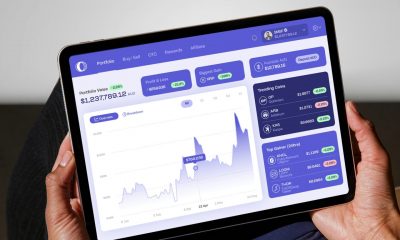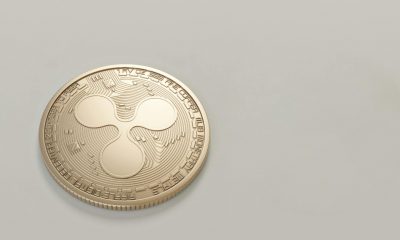

others
Pound Sterling advances on improved market sentiment – Crypto News
- Pound Sterling has stretched its upside recovery as the appeal of risky assets improves.
- UK recession fears have faded on prospects of early BoE rate cuts.
- Fed policymakers refuse to provide timing of rate cuts amid uncertainty over inflation.
The Pound Sterling (GBP) shows bullish moves in the European session on Wednesday as the appeal for risk-perceived assets has improved significantly. The GBP/USD rebounds strongly despite increasing prospects of early rate cuts by the Bank of England (BoeE). After BoE Chief Economist Huw Pill, BoE Deputy Governor Sarah Breeden has also emphasized how long interest rates should remain restricted. Recent commentaries from BoE policymakers show that the central bank could begin reducing interest rates sooner.
The UK’s construction and service sectors have rebounded as prospects of rate cuts by the BoE have deepened amid easing price pressures. This has improved the confidence of business enterprises in the economic outlook.
The US Dollar has come under pressure despite the Federal Reserve (Fed) now expecting not to rush rate cuts amid a resilient United States economy. Fed policymakers continue to ignore discussions about the timing of rate cuts as the inflation situation is still uncertain due to robust labor market conditions and retail demand.
Daily Digest Market Movers: Pound Sterling rises while US Dollar corrects from 11-week high
- Pound Sterling has extended its upside above 1.2600 as the United Kingdom’s economic prospects improve despite the Bank of England (BoE) maintaining interest rates in the restrictive trajectory.
- After robust Services PMI data, UK S&P Global/CIPS Construction PMI rose sharply to 48.8 vs. expectations of 47.3 and the prior reading of 46.8.
- UK construction companies have become more optimistic about fading recession risks and rate cuts by the BoE amid easing price pressures.
- Deepening prospects of loosening financial conditions and improving economic outlook have improved business optimism.
- The odds of early rate cuts by the BoE escalated after a dovish guidance on interest rates by Bank of England Chief Economist Huw Pill.
- Huw Pill said on Monday that the central bank is now focusing on “when” rather than “if” it will start lowering its benchmark interest rates. Pill added inflation indicators are far from endorsing the commencement of an easy policy but the underlying inflation is not needed to return to 2% for rate cuts.
- Also, Stephen Millard, a NIESR deputy director, said the good news for 2024 was that wages would continue to rise while inflation fell quickly towards the BoE’s 2% target, probably allowing the central bank to start cutting interest rates in May, Reuters reported.
- For fresh guidance on interest rates, investors will keenly observe how the labor market and service inflation will shape up.
- The US Dollar Index (DXY) has come under pressure despite investors losing conviction over rate cuts by the Federal Reserve in May.
- As per the CME Fedwatch tool, traders see a 53% chance for a rate cut by 25 basis points (bps) in May, which has come down as policymakers push back expectations of early rate cuts.
Technical Analysis: Pound Sterling aims stabilization above 1.2600
Pound Sterling advances above the round-level resistance of 1.2600 as the risk-appetite of the market participants is improving again. The GBP/USD pair recovers strongly after discovering buying interest near a seven-week low around 1.2500. The near-term outlook of the Cable is still downbeat as it is trading below the 20 and 50-day Exponential Moving Averages (EMAs), which trade around 1.2664 and 1.2634 respectively.
BoE FAQs
The Bank of England (BoE) decides monetary policy for the United Kingdom. Its primary goal is to achieve ‘price stability’, or a steady inflation rate of 2%. Its tool for achieving this is via the adjustment of base lending rates. The BoE sets the rate at which it lends to commercial banks and banks lend to each other, determining the level of interest rates in the economy overall. This also impacts the value of the Pound Sterling (GBP).
When inflation is above the Bank of England’s target it responds by raising interest rates, making it more expensive for people and businesses to access credit. This is positive for the Pound Sterling because higher interest rates make the UK a more attractive place for global investors to park their money. When inflation falls below target, it is a sign economic growth is slowing, and the BoE will consider lowering interest rates to cheapen credit in the hope businesses will borrow to invest in growth-generating projects – a negative for the Pound Sterling.
In extreme situations, the Bank of England can enact a policy called Quantitative Easing (QE). QE is the process by which the BoE substantially increases the flow of credit in a stuck financial system. QE is a last resort policy when lowering interest rates will not achieve the necessary result. The process of QE involves the BoE printing money to buy assets – usually government or AAA-rated corporate bonds – from banks and other financial institutions. QE usually results in a weaker Pound Sterling.
Quantitative tightening (QT) is the reverse of QE, enacted when the economy is strengthening and inflation starts rising. Whilst in QE the Bank of England (BoE) purchases government and corporate bonds from financial institutions to encourage them to lend; in QT, the BoE stops buying more bonds, and stops reinvesting the principal maturing on the bonds it already holds. It is usually positive for the Pound Sterling.
-

 Technology6 days ago
Technology6 days agoMeet Matt Deitke: 24-year-old AI whiz lured by Mark Zuckerberg with whopping $250 million offer – Crypto News
-

 Cryptocurrency7 days ago
Cryptocurrency7 days agoXRP inflows drop 95% since July spike, while Chaikin data signals possible rally – Crypto News
-

 Blockchain6 days ago
Blockchain6 days agoBank of America Sees Interest in Tokenization of Real-World Assets – Crypto News
-

 Technology1 week ago
Technology1 week agoIs AI causing tech worker layoffs? Thats what CEOs suggest, but the reality is complicated – Crypto News
-
others7 days ago
Breaking: Strategy Files $4.2 Billion STRC Offering To Buy More Bitcoin – Crypto News
-
others7 days ago
XRP NIGHT Token Airdrop: Snapshot, Claim Date and What to Expect? – Crypto News
-

 Blockchain1 week ago
Blockchain1 week agoSEC Crypto ETFs Ruling Brings Structural Fix, Not Retail Shakeup – Crypto News
-
Business1 week ago
Breaking: Solana ETFs Near Launch as Issuers Update S-1s With Fund Fees – Crypto News
-

 Blockchain5 days ago
Blockchain5 days agoAltcoin Rally To Commence When These 2 Signals Activate – Details – Crypto News
-
Cryptocurrency5 days ago
Cardano’s NIGHT Airdrop to Hit 2.2M XRP Wallets — Find Out How Much You Can Get – Crypto News
-

 Business1 week ago
Business1 week agoChase Launches $4 Million Grant Program as Restaurants Struggle – Crypto News
-
others1 week ago
Ripple Swell 2025: Top Speakers and Panelists to Watch this November – Crypto News
-

 Technology7 days ago
Technology7 days agoOppo K13 Turbo series confirmed to launch in India with in-built fan technology: Price, specs and everything expected – Crypto News
-

 others1 week ago
others1 week agoBlockchain Gaming Is Growing Up – What’s Behind the Sector’s Quiet Comeback – Crypto News
-
Business1 week ago
Stablecoins Won’t Boost Treasury Demand, Peter Schiff Warns – Crypto News
-
Technology1 week ago
Coinbase to Offer Tokenized Stocks and Prediction Markets in U.S. – Crypto News
-

 others7 days ago
others7 days agoCanadian Dollar under pressure amid weak GDP, Trump tariff threat, and strong US data – Crypto News
-
Business6 days ago
Bitpanda Co-Founder & Co-CEO Paul Klanschek Steps Down as Firm Eyes Frankfurt IPO – Crypto News
-
Technology4 days ago
Beyond Billboards: Why Crypto’s Future Depends on Smarter Sports Sponsorships – Crypto News
-

 others1 week ago
others1 week agoEUR/USD dives as the US Dollar outperforms with all eyes on the Fed decision – Crypto News
-
others1 week ago
Breaking: PayPal to Let Merchants Accept Payments in Over 100 Cryptocurrencies – Crypto News
-

 Blockchain1 week ago
Blockchain1 week agoSEC Gives Green Light to In-Kind Transactions for Crypto ETPs – Crypto News
-

 Metaverse1 week ago
Metaverse1 week agoOpenAI rolls out ‘Study Mode’ in ChatGPT: What is it? How to use? All your questions answered… – Crypto News
-
Technology1 week ago
Breaking: BlackRock’s Ethereum ETF Staking Proposal Advances As SEC Acknowledges Filing – Crypto News
-
Technology1 week ago
Ethereum Price Prediction- Bulls Target $5,400 Amid DeFi Revival and Soaring TVL – Crypto News
-

 Technology1 week ago
Technology1 week agoCoinbase exchange targets alleged cybersquatter in lawsuit – Crypto News
-

 De-fi1 week ago
De-fi1 week agoWhite House Crypto Report Recommends Expanding CFTC’s Role in Crypto Regulation – Crypto News
-

 Technology6 days ago
Technology6 days agoBig Tech’s Big Bet on AI Driving $344 Billion in Spend This Year – Crypto News
-
Cryptocurrency6 days ago
CME XRP Futures Hit Record Highs in July Amid ETF Approval Optimism – Crypto News
-

 Cryptocurrency5 days ago
Cryptocurrency5 days agoStablecoins Are Finally Legal—Now Comes the Hard Part – Crypto News
-

 Cryptocurrency5 days ago
Cryptocurrency5 days agoTron Eyes 40% Surge as Whales Pile In – Crypto News
-

 Cryptocurrency5 days ago
Cryptocurrency5 days agoEthereum Hits Major 2025 Year Peak Despite Price Dropping to $3,500 – Crypto News
-

 Technology1 week ago
Technology1 week agoSpotify hits 276M subscribers and strong user growth in Q2, but revenue and profit fall short of targets – Crypto News
-

 Cryptocurrency1 week ago
Cryptocurrency1 week agoAltcoins update: Dogecoin and Injective signal recoveries as Ethereum eyes $4,000 – Crypto News
-
Business1 week ago
Breaking: CBOE Files For Rule Change To List Crypto ETFs Without SEC Approval – Crypto News
-

 Technology1 week ago
Technology1 week agoSolana DEX volume dips 20% after co-founder slams meme coins – Crypto News
-

 Technology7 days ago
Technology7 days agoTim Cook confirms Apple will ramp up AI spending, ‘open’ to acquisitions – Crypto News
-

 Technology7 days ago
Technology7 days agoOppo K13 Turbo series confirmed to launch in India with in-built fan technology: Price, specs and everything expected – Crypto News
-

 Blockchain6 days ago
Blockchain6 days agoStrategy Expands STRC Offering Twice in One Week – Crypto News
-
Technology5 days ago
Will The First Spot XRP ETF Launch This Month? SEC Provides Update On Grayscale’s Fund – Crypto News
-

 Technology5 days ago
Technology5 days agoAmazon Great Freedom Sale deals on smartwatches: Up to 70% off on Samsung, Apple and more – Crypto News
-

 Blockchain5 days ago
Blockchain5 days agoXRP Must Hold $2.65 Support Or Risk Major Breakdown – Analyst – Crypto News
-

 Blockchain5 days ago
Blockchain5 days agoXRP Must Hold $2.65 Support Or Risk Major Breakdown – Analyst – Crypto News
-
Business4 days ago
Is Quantum Computing A Threat for Bitcoin- Elon Musk Asks Grok – Crypto News
-

 Technology4 days ago
Technology4 days agoElon Musk reveals why AI won’t replace consultants anytime soon—and it’s not what you think – Crypto News
-

 Technology4 days ago
Technology4 days agoGoogle DeepMind CEO Demis Hassabis explains why AI could replace doctors but not nurses – Crypto News
-

 Cryptocurrency1 week ago
Cryptocurrency1 week agoCoinbase and JPMorgan Chase partner for crypto integration – Crypto News
-

 others1 week ago
others1 week agoGold slides below $3,300 as traders await Fed policy decision – Crypto News
-

 others1 week ago
others1 week agoGold slides below $3,300 as traders await Fed policy decision – Crypto News
-

 Technology1 week ago
Technology1 week agoNintendo Direct Partner showcase highlights third-party titles coming to Switch and Switch 2 – Crypto News












